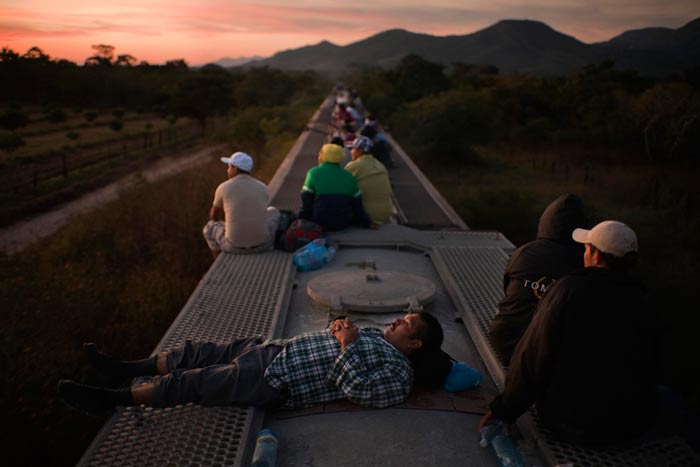The Museum of Contemporary Photography closed 2010 with a provocative exhibit called “La Frontera: The Cultural Impact of Mexican Migration.” Depicting a massive instillation of prose-poetry from Ben Sáenz, expository documentation of the border patrol and the fence that stretches across the desert, dividing land, people, families and cultures, “La Frontera” ambitiously traveled an arduous geopolitical and emotional terrain. Showcasing the travesties of narco murders while juxtaposing the often overlooked cultural exchange of migrant communities from Iowa City to Oaxaca, from Sonora to Chicago’s Pilsen community, “La Frontera” like the border identity of bi-national immigrant families reaches wide and far.
My initial yet imperative critique can be shortly stated and alleviated. The exhibit had little to no substantial reference to the femicide of the Mujeres de Juárez. But, one cannot expect such a humble museum to undertake the enormous burden of representing the entire state of affairs on the bordrelands and border issues. The National Museum of Mexican Art’s recent exhibit on the Mujeres of Juárez serves as a reference to the overwhelming emotion and the sheer magnitude of such a taxing endeavour. However, an exhibit that doesn’t reference the heinous murder of more than 500 women on the terrain it aims to document and analyze, seems a note worthy concern, to say the least. My second critique stems less from the exhibit and more towards the poorly worded press release that promoted the otherwise evocative exhibit.
Fortunately I did not read the press release written by MoCP Director, Rod Slemmons, until after my arrival home from the exhibit. قمار الخيل Slemmons’ unfortunate use of very contested descriptions for those very people one assumes his curated exhibit aims to represent, might have dissuade my patronage. Slemmons’ misguided use of the word’s “illegal aliens,” “illegal populations,” “illegal immigrants,” and “illegals,” vs his apt description of “illegal entries” or “illegal immigration” as violations of political circumstance, might have turned away any die hard immigrant activist, academics, and humanitarians among us.

David Rochkind, Train headed north with potential migrants to the US in southern Mexico
As a matter of fact, people, human beings, in whatever state they may find themselves, in whatever country, regardless of their sociopolitical standing can never be and should never be referred to as “illegal.” People’s actions, their crossing arbitrary and imaginary lines, laws or taboos, might be appropriately deemed “illegal,” but humans, their thoughts, their bodies, their lives and stories must remain outside of the delineations of repressive governmental verbiage. The exhibit, keeping in line with its aims to counteract the ” harmful abstractions and over simplifications in the media,” works well as a remedy, shooting beyond the stagnant narratives and charged diction of the press. روليت مجاني The disheartening and offensive description of people as “illegals” and worse, “aliens,” only further polarize and discriminate, counteracting the exhibits intentions.
However, as a child of immigrants, walking through the MoCP an exhibit space I used to frequent as a young man, yearning for art while ditching high school or when home on vacation from college, seeing for one of the first times my story and my people’s story on the walls of such a familiar, yet at at times isolating space, “La Frontera” moved me to tears more than once. Jaun Pacheco’s raw “nontraditional portraits” boldly reflect so much of the stigmatization and isolation struggled by men of color in this country. Marcela Taboada’s photojournalism recalled the tapestry of Lola Alvarez Bravo’s vivid depictions of life and beauty in México. Michael Hyatt’s image of a dusty, torn copy of the Diary of Ann Frank in a migrant camp poignantly depicts the brutality and resilience inherent to these perpetual and daunting migrations.
One would not have expected to be so unabashedly thrust into the heart of the matter with such concern and clarity. Sitting in silence on the steps of the final room of the exhibit, watching the monotonous, repetitive motions of the factory workers, in Yoshua Okón triptych video stream of maquiladora workers packaging “Bergson – canned laughter,” I was moved to tears yet again, remembering my grandfather’s hands, the mutilated stubs of his thumb and index fingers, calloused over the years after being severed in a pinball machine factory in Chicago years ago. As an undocumented immigrant he was never compensated for the work related injury. The irony of his blood dripping a pin ball machine, a symbol of leisure and luxury in the U.S., sat earily with me as I absorbed Okón’s œuvre magnifique.
The border is no easy terrain to trace or tackle. كازينو عربي I appreciate the MoCP for it’s earnest and outstanding approach to the subject. I commend the MoCP for grappling a tenuous topic with grace, humility, and humanity.